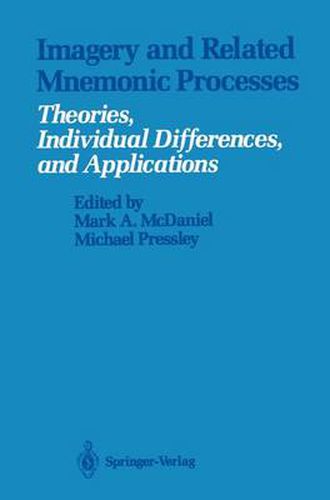Readings Newsletter
Become a Readings Member to make your shopping experience even easier.
Sign in or sign up for free!
You’re not far away from qualifying for FREE standard shipping within Australia
You’ve qualified for FREE standard shipping within Australia
The cart is loading…






This title is printed to order. This book may have been self-published. If so, we cannot guarantee the quality of the content. In the main most books will have gone through the editing process however some may not. We therefore suggest that you be aware of this before ordering this book. If in doubt check either the author or publisher’s details as we are unable to accept any returns unless they are faulty. Please contact us if you have any questions.
Scientific work on mnemonics and imagery conducted in the 1960s and early 1970s was directed at testing enthusiastic claims of the efficacy of memory tech niques developed by the ancient Greeks and further refined in the popular litera ture by professional mnemonists. The early research on imagery and mnemonics confirmed many of these claims and also illuminated the limitations of some techniques (e. g. , bizarre imagery). As such, these seminal studies clearly were valuable in providing a solid data base and, perhaps as important, making imagery and mnemonics acceptable research areas for experimental psycholo gists and educators. After this initial surge of work, however, it seemed that sub sequent contributions met with the attitude that mnemonic techniques and imagery help memory, what else is new? This attitude was not completely justi fied, however, given the theoretical insights from the work of such imagery and mnemonics pioneers as Gorden Bower, Allan Paivio, and William Rohwer. In the 1980s this claim is completely unjustified. Research on mnemonics and imagery has grown in exciting ways. Researchers are tapping the area’s theoretical potential, both in terms of extending basic memory theories to account for the robust effects produced by mnemonic techniques and in terms of using explanations of mnemonic effects to understand basic memory processes. Individual differences in the use of imagery and mnemonic encoding activities are also being explored. This research has provided valuable information for basic memory theories (e. g.
$9.00 standard shipping within Australia
FREE standard shipping within Australia for orders over $100.00
Express & International shipping calculated at checkout
This title is printed to order. This book may have been self-published. If so, we cannot guarantee the quality of the content. In the main most books will have gone through the editing process however some may not. We therefore suggest that you be aware of this before ordering this book. If in doubt check either the author or publisher’s details as we are unable to accept any returns unless they are faulty. Please contact us if you have any questions.
Scientific work on mnemonics and imagery conducted in the 1960s and early 1970s was directed at testing enthusiastic claims of the efficacy of memory tech niques developed by the ancient Greeks and further refined in the popular litera ture by professional mnemonists. The early research on imagery and mnemonics confirmed many of these claims and also illuminated the limitations of some techniques (e. g. , bizarre imagery). As such, these seminal studies clearly were valuable in providing a solid data base and, perhaps as important, making imagery and mnemonics acceptable research areas for experimental psycholo gists and educators. After this initial surge of work, however, it seemed that sub sequent contributions met with the attitude that mnemonic techniques and imagery help memory, what else is new? This attitude was not completely justi fied, however, given the theoretical insights from the work of such imagery and mnemonics pioneers as Gorden Bower, Allan Paivio, and William Rohwer. In the 1980s this claim is completely unjustified. Research on mnemonics and imagery has grown in exciting ways. Researchers are tapping the area’s theoretical potential, both in terms of extending basic memory theories to account for the robust effects produced by mnemonic techniques and in terms of using explanations of mnemonic effects to understand basic memory processes. Individual differences in the use of imagery and mnemonic encoding activities are also being explored. This research has provided valuable information for basic memory theories (e. g.